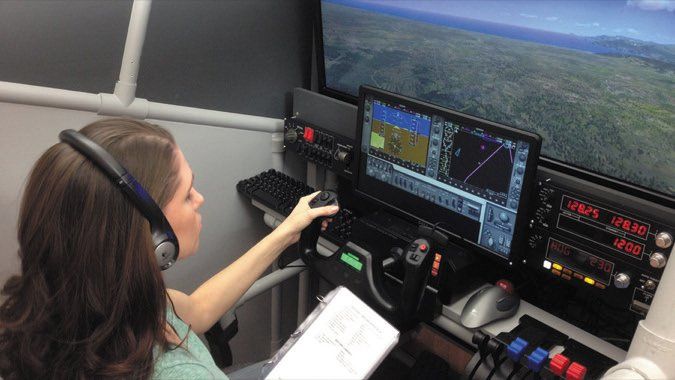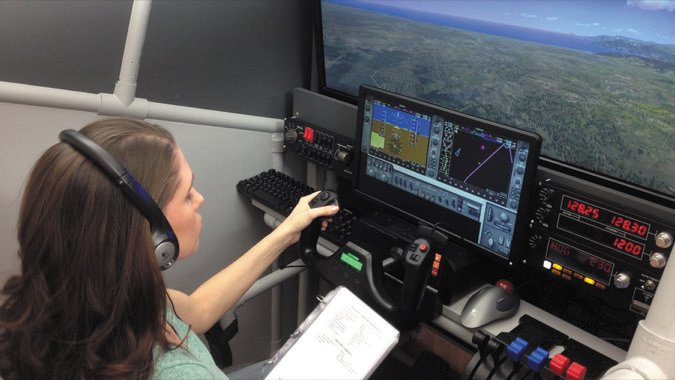
Thinking rating, toughest rating, necessary rating, unnecessary rating—all descriptions we’ve heard of the instrument rating. No matter what you call it, the instrument ticket is virtually essential if you wish to fly professionally or, in our opinion, get the most out of ownership of a GA airplane designed for traveling.
We wanted to find out what’s available for instrument training following the FAA’s switchover to the new Airman Certification Standards (ACS) last year and see if there’s a “best way” to approach getting the instrument rating.
We reviewed internet-based and downloadable ground training courses and generally available flight training programs. The bottom line is that we liked all of the courses designed to get you through the written exam but felt that Sporty’s and King edged out the others because of their presentation and content.
We like flight programs that provide an organized syllabus that makes extensive use of simulators and—if the student hasn’t passed the written—gets them ready for it before they’ve gone more than about halfway through the program. The Cessna Pilot Center instrument rating course—designed with input from King Schools—is a model we like.
We recommend that any pilot who wants to get the rating efficiently should be prepared to go at it intensely—flying a bare minimum of three days a week—otherwise too much is lost between lessons. We are advocates of total immersion training—that’s how the military, airlines and type rating schools do it. Accordingly, we think the 10-day training course model is a good one and like the company that’s been doing it for over 35 years, PIC.
Written Test Prep
For pilots who prefer to take training for the instrument written exam at home, there are several good courses available. We surveyed what we felt were the most popular to see what they cost, how convenient they were to use—do they require internet connection and whether they can be used on multiple devices—and how they approached getting a student ready for the written exam. Frankly, we prefer instrument written exam training courses that go we’ll beyond training for the questions on the written—we think a well-educated, well-rounded instrument pilot is a safer pilot.
We note that the FAA quit publishing its full database of questions and answers to the writtens over 10 years ago. It now publishes sample questions quarterly. It constantly makes subtle changes to the questions and answers. We’re unwilling to believe any claims that a test prep company has all of the questions in its databank—although we know all of them work like crazy to be as up-to-date as possible.
The FAA’s changeover to the ACS last year meant major changes to the written test questions. The test prep companies all assert that they’ve smoothly made the transition. We think that’s true; however, if your prep course has questions on the ADF, it’s out of date.
Sheppard Air
We’re starting with the Sheppard Air (www.sheppardair.com) test prep course because we like it and we don’t like it. We don’t like it because it unabashedly is designed just to train a pilot to pass the FAA written and that’s it.
We like it because it only costs $45 and we think that if you take the course in accordance with the detailed instructions, the odds are very good that you’ll pass the written with a high score.
It’s a course that you download onto your computer (PC or Mac) or tablet—but only one device. Once downloaded you do not have to have internet connectivity as you study.
Sheppard Air encourages the student to memorize the test questions, even going so far as to say that if a mathematical calculation is going to take more than 30 seconds the student should not bother doing it—just “learn the concept” and memorize the answer.
In our opinion, the course is we’ll organized. The presentation is stark, with no frills. The student is directed to go through each subject area by first looking at the questions with only the correct answer displayed. There is an explanation box with a brief outline as to why the answer is correct. The Sheppard Air website is linked to a large library of FAA publications should the student desire to read the background material relied on by the FAA for its choice of a correct answer.
Once the student has completed the initial task, the next step is to go through all of the questions again and learn to recognize the correct answer.
Once the student has completed the process in all subject areas, Sheppard recommends taking not more than two practice exams. Once the student gets a score of at least 90 percent, Sheppard issues a completion certificate and strongly recommends that the student take the FAA written within 24 hours.
The course comes with a money-back guarantee if you don’t get at least a 90 on the FAA written.
We like that Sheppard has a 24-hour-a-day help line staffed by instrument instructors that it repeatedly encourages customers to call.
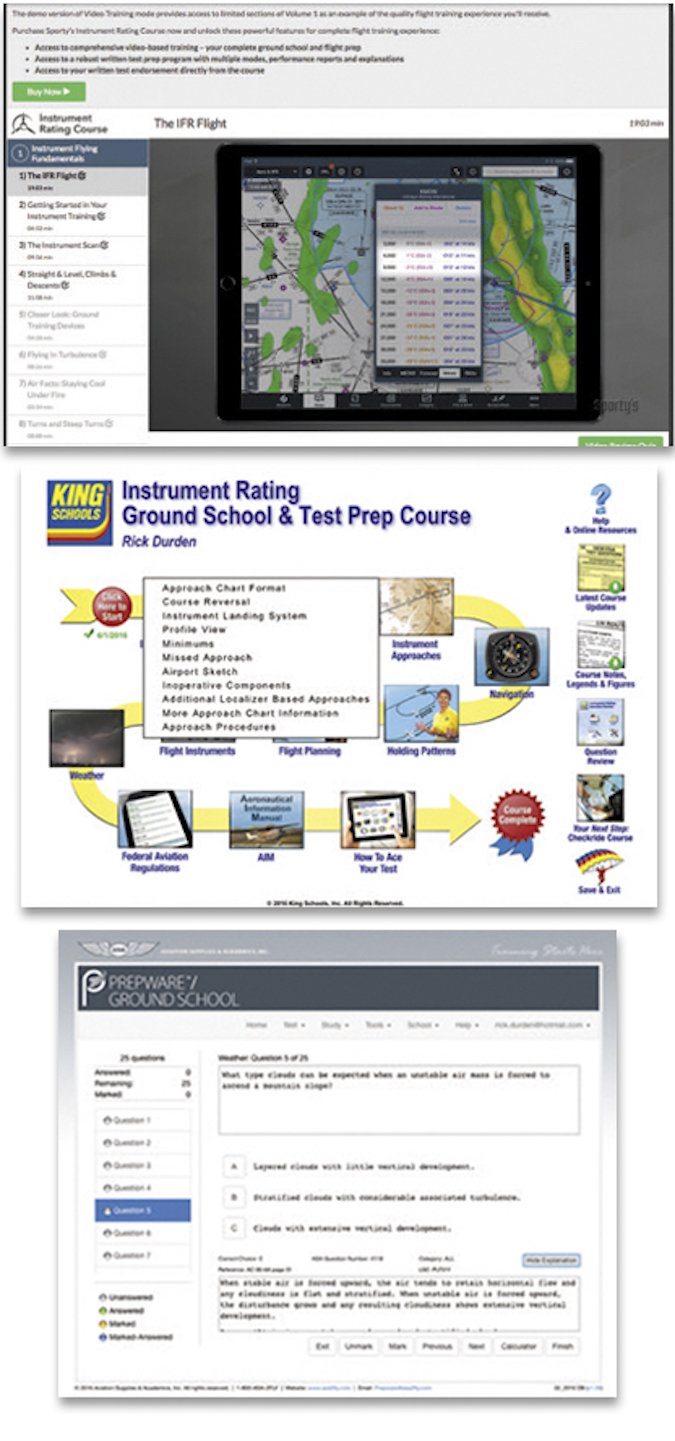
Gleim
One of the mainstays of the aviation education world, Gleim (www.gleimaviation.com) offers a number of online courses for a pilot working on the instrument rating ranging from a $64.95 online written test prep through a $99.95 instrument rating ground school and a combination of the two for $149.95, through a $209.95 deluxe instrument pilot kit. While it’s beyond the scope of this article, Gleim also offers an instrument rating test prep book for $24.95.
An online course purchase is good for 12 months. Consistent with its competitors, Gleim regularly updates the course during the year after you purchase it when Gleim learns of changes to the FAA written.
We looked at the instrument rating ground school rather than the test prep course because it is guaranteed. Gleim’s courses have always been focused, not flashy. The online ground school is no exception.
The course breaks the material into 11 study units with each further broken into subunits that can usually be digested in no more than 10 minutes. There is an optional 10-minute video for each of the 11 study units. While the student can go through the material in any order, we think that the best approach is to take it in the order presented because a section often builds on material from a previous section. Gleim indicates that the full course takes an average of 35 hours to complete.
After going through a subunit the student is directed to a study session to take FAA questions pertaining to that subunit. When an answer is selected there is immediate feedback, in detail, as to why the answer is correct or not—and allows the student to click on a question mark for additional help.
We thought the clarity of FAA test figures and charts was excellent.
Upon successful completion of the required questions in a practice test the course generates a completion certificate that functions as an endorsement to take the FAA knowledge test.
Dauntless
At $48.99, the “GroundSchool” instrument rating test prep from Dauntless (www.dauntless-soft.com) may be downloaded to any one device—PC, Mac, Android or iPhone. It is a pure test prep program; however, the method of “learning by simulated testing” does not rely as much on rote memorization as other pure test prep systems.
Dauntless points out that it feels that automaton pilots are not good pilots and that the FAA discourages rote memorization—it wants pilots who understand concepts—so it constantly makes subtle changes to test questions and answers.
Accordingly, Dauntless refers to its method of presenting test questions and answers as “active learning by doing” in that it helps the student understand the why of the material so they will not be fooled by subtle test question answers.
As with its competitors, Dauntless breaks the material, and FAA test questions, into sections. The student starts with seeing just the question and correct answer and works into progressively more demanding study levels—all the while having high-quality graphics and detailed explanations that support and explain the correct answer.
“Question stacks” are created through which questions related to an area in which a student has missed a question come up more frequently so the student can concentrate on weak areas.
The student can elect to display his or her progress and share it with heror his flight instructor. It’s a free service; the student gives the instructor password-limited access to portions of the generated data.
We liked that the software can duplicate the appearance of the FAA written test questions as they appear at the various testing centers.
We like the Dauntless approach to teaching for the written test, but we were surprised by the absence of a money-back guarantee on the website.
Instrument Training In IMC? Yes!
I’ve never felt it was appropriate that a pilot could obtain an instrument rating without flying in the clouds. From a safety standpoint—no matter what type of flying the pilot intends to undertake—it seems beyond ludicrous. I received instrument dual in IMC at a small airport in rural Iowa; one would think that it would be a basic part of the syllabus of every flight school or independent instructor.
It’s not and it’s not required by the FARs. However, the FARs are, by law, only minimum standards. I’m uncomfortable with the idea of flight schools and instructors only teaching to minimum standards and no more.
I think that some degree of seasoning should be provided to pilots who are obtaining ratings—so that they are not loosed on the aviation world capable of the monkey motion of steering the airplane, able to talk with ATC and quote regulations verbatim, but without experience in making the go/no-go weather decisions outside of hypothetical scenarios. In my opinion, because the FAA has disregarded its obligation to establish appropriate training requirements in IMC, flight schools and instructors have an ethical obligation to go beyond the FAA’s standards for an instrument rating and take their instrument students into actual IMC on a regular basis.
Because of my profession (I’ve been an attorney involved with aircraft accident litigation for several decades), I’ve looked closely at far too many accidents that occurred in instrument conditions to pilots with instrument ratings but little actual time flying in clouds. We humans evolved on the surface of this planet and have only been creatures of the sky since we started flying balloons in 1783—evolutionally a flicker of an eyelash of time. A tremendous amount of what we experience in flight is without parallel to our experiences on the ground. Our inbred, ground-based instincts and reactions get triggered by the sensations of flight, and unfortunately, they are often dead wrong when it comes to what is appropriate when moving about the sky. As a result, we have to learn nearly everything formally when we step into the third dimension. So, when first flying VFR, we go with flight instructors. I feel that when we first fly inside a cloud it’s also a wise idea to do so with an instructor.
I want an experienced CFII in the right seat as safety net for a pilot’s first foray into the clag, because the decision that pilots will be making means potentially looking death in the face, and I want the pilot alive. I don’t think books and lessons and lectures and hangar flying fully prepare a pilot for the overwhelming desire to land that comes about when a runway is glimpsed, even if only momentarily. Such an urge, if not resisted, can lead to either foolishly continuing a descent while in a “little” cloud or, even worse, trying to circle over a runway and land on it when the vertical visibility is 500 feet, and the horizontal visibility is the same.
I’ve flown with instrument students when the weather was low enough to necessitate a real missed approach. New instrument pilots are primed for landing out of an approach—hey, it’s the normal end to an approach. we’ll . . . not always, and that can be stunningly difficult for a pilot to accept.
A real missed approach usually causes distinct psychological reactions that, from my observations and reading accident reports, can’t be duplicated in a simulator or under the hood. It takes an aircraft, clouds, uncertainty and cold sweat. I think it would be wise for an instructor to be there in case the left-seater falls off the tightrope.
In my opinion, an instrument student should demand dual in IMC. I also think CFIIs and flight schools should be eager to provide it.
—Rick Durden
ASA
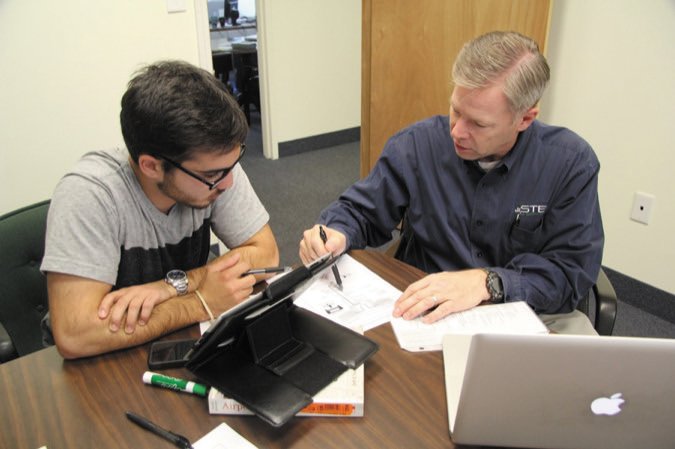
Respected for its high-quality aviation textbooks, online courses and test prep materials, ASA (www.asa2fly.com) offers an instrument pilot online course for $199.95. For that you get 10 hours of video presentations, a digital textbook and ASA’s Prepware that is designed to get a pilot ready for the written test. This is a full instrument rating course, although the $49.95 Prepware can be purchased separately.
The online course may be accessed via PC, Mac, tablet or mobile device compatible with Apple and Android systems.
The course is structured so that the student reads the textbook chapters, views the applicable video and then accesses the Prepware. Once into Prepware, the FAA-style written questions are presented twice, once as a study session with feedback on each answer and then as a quiz that is timed and scored.
We’ve been impressed with the quality and content of ASA’s books—this is no exception. The videos are not quite as good as those in more expensive courses.
Upon completion of the course and two practice tests with a score of at least 80 percent, ASA provides an endorsement for the written exam.
Purchase of the course gives 24-month access, so once the written is passed, it’s an excellent reference for the checkride and beyond.
Sporty’s
We were impressed by the $199.95 instrument rating online course offered by Sporty’s (www.sportys.com) for a lot of reasons. It was good when we looked at it several years ago, it’s even better now and it offers a money-back guarantee that you’ll pass the written.
The course can be accessed online, as an iPhone/iPad app or through the Apple TV app. There’s no Android. It also allows your CFI to track your progress.
The course is via over 13 hours of videos that are some of the most professionally produced and content-rich we’ve seen. They go we’ll beyond what’s needed for the written toward making a well-rounded instrument pilot. Complex material is broken down in what we consider to be sensible fashions. The appropriate section of the ACS is referenced throughout the videos.
At the end of each video is a review quiz in FAA-question format and a direct link back to the relevant section of the video for each question. If you get stumped, you can click on “Ask a CFI” and get help.
Completing two practice tests with a score of at least 80 percent generates an endorsement for the written, which will appear in your ForeFlight logbook.
King
The other big dog in the aviation training world, King Schools (www.kingschools.comx) offers a series of instrument rating courses from checkride only, through written only, written and checkride to written and checkride as we’ll as several pilot skills courses and various pilot gear. We looked at the $279 Written Only course and came away impressed.
The course can be synced to any Apple device. Passing the written is guaranteed and the price allows unlimited lifetime access, unlimited access to FAA-style practice tests and automatic updates, something no other provider offers.
As with its competitors, the course is broken down into major subject areas. It gives a recommended flow through the areas. Clicking on a subject icon brings up the lesson groups, which are further broken down into lessons, usually three to six. Clicking on a lesson opens up the high-quality video, which lasts about 10 minutes.
Following the video, the first review question appears. Immediate feedback on the answer provided and a running report card is kept.
The entire library of review questions can be accessed at any time. King updates the course with “hot sheets” flagged to alert students to changes. Completion of the course requires a score of at least 70 percent on three practice tests. Once that is accomplished an endorsement for the FAA written is generated.
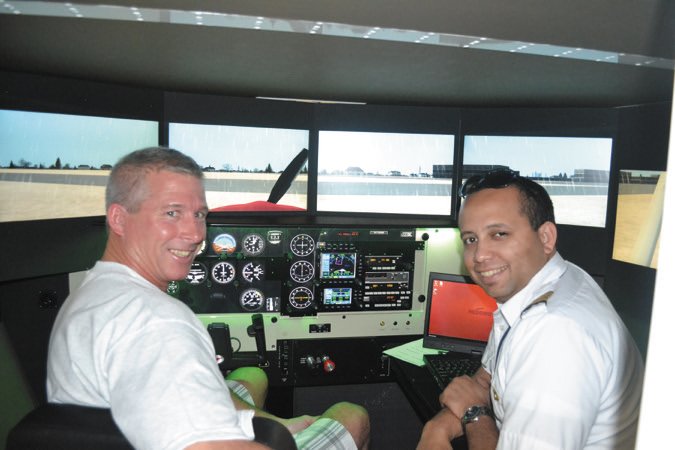
Over A Weekend
Most flight schools offer instrument rating ground schools on a regular basis. Most meet about once a week and use commercially available materials to train the students. The quality is all over the place and varies by school and instructor. We aren’t going to try to make recommendations.
However, weekend ground schools for the instrument rating have been around as long as we can remember. They cater effectively to the pilot who knows her style of learning and it’s not finding time to sit down in front of the computer every day to go through a course. He wants to step aside from the world for two days or so, be force-fed the material and pass the written.
We’ve done it and think it works for a lot of people, although not everyone. While we got the highest score we’ve ever gotten on a written after a weekend ground school, a friend couldn’t absorb the material fast enough, failed the written twice and found that the best way was to sit down for some extensive one-on-one tutoring with a CFII.
Our survey showed prices from $250 to $450. The bottom line, in our opinion, is deciding to go to a weekend course, then get online and find out when one will be offered in your area. The price of the course is often secondary to the cost of your transportation, lodging and meals.
In our opinion, it is possible to prep for the instrument written in two days over a weekend, provided you take the exam immediately. The course isn’t going to make you a well-rounded instrument pilot, but it will probably get you through the written successfully.
The Flying Part
Over years of taking dual, giving dual and interviewing pilots and flight instructors, we’ve learned what educators who have been collecting objective data on flight training have been saying is true—the most efficient method of getting a rating istotal immersion. That’s why the military, airlines and type rating schools all follow the total immersion model.
Immersion Works
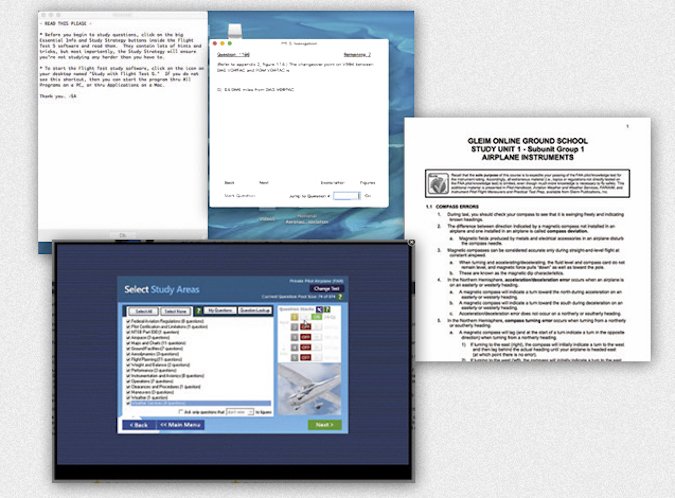
We’ve heard the claim that pilots who go the total immersion or “accelerated” training route don’t really learn the material. They dump it like a bad load of software right after the checkride. The assertion is nonsense—there’s no data to support it. What matters on the question of retention is continuing to use the new knowledge, skills and judgment after the checkride.
There are a number of ways a pilot can go the total immersion route for instrument flight training—coordinating it with a local flight school or CFII, traveling to a school that offers accelerated training or contracting with a school that sends an instructor to you.
Among the last, we like the model that Professional Instrument Courses (PIC) (www.iflyifr.com) has been honing since 1980—10, eight-hour training days and a checkride. In its program, the instructor comes to the student, flight simulator in hand, and usually does the ground and simulator training in the student’s house.
To start the course (as with all such accelerated courses we checked) the student has to have passed the instrument written. PIC program director Tom Seymour told us that he also strongly recommends that the pilot be VFR current in the airplane to be used.
Following the PIC syllabus and proprietary course materials, the student goes through one-on-one ground school, training on a BATD simulator for at least all of the time that can be legally logged on the device toward the instrument rating, and flight time in the airplane arranged for by the student. PIC instructors give flight instruction in IMC, something we think is essential for any instrument flight training.
Pilots who have taken the course reported that they flew every day except when the weather was too bad—icing, thunderstorms and/or no viable weather alternates—or the airplane broke.
Our research indicated that most pilots who take the PIC 10-day course get through it in the time dedicated or in one or two more days. Where there were problems, we observed that it was because of weather, the airplane breaking, the pilot not devoting the time to the lessons and homework (a few hours each evening), there was a personality clash between the student and instructor or the student was simply not able to absorb the material fast enough—most often because she or he was over 60. Cost for the PIC program is $6100 plus expenses for the instructor (travel, hotel, meals). If it takes additional time, there is additional cost.
We found that price to be similar to other 10-day instrument schools we surveyed—and some that promise the rating in seven days—although we express some skepticism on that timeline. Most of the schools send the instructor to you; some do the training at their facility or give you the option of their place or yours.
Tailored Immersion
Most of the “accelerated” schools and courses have programs for pilots who have taken some instrument instruction and want to quit messing around and finish up. They should be willing to tailor the instruction to you—and take fewer than 10 days for the course.
Based on our research we have a number of recommendations for pilots considering an accelerated school:
• Make sure that you can schedule your checkride within a day or two of the completion of training, or that you can get a follow-up training session within a day or two prior to the checkride. When you complete your training, you’re ready for the checkride. That readiness drops off fast. There is a major shortage of Designated Pilot Examiners (DPEs) right now; plan accordingly.
• Make sure the instructor will train in IMC—and take advantage of it.
• It’s rare, but it’s a fact of life as human beings—find out what can be done if you and the instructor just cannot work together.
• Make sure the airplane you are going to use is ready to go and that everything works—and that your favorite shop can fix small stuff that might break on very short notice.
• Be up to date on VFR skills in the specific airplane and able to intercept and track a VOR radial and know how the VOR system works—it may be obsolescent, but it’s on the checkride.
• Be willing and able to absolutely clear the decks for the entire training period—no business or family obligations or interruptions.
If you want to train at a local flight school, we recommend that it be at a school that has an organized syllabus (along the lines of the Cessna Pilot Center program) and has a simulator that meets the requirements for logging time for the instrument rating. We can’t recommend simulator training highly enough—it lets you focus on specific tasks, do such things as multiple approaches in minimal time and it’s much cheaper than doing the same thing in the airplane.
The school should be amenable to your schedule and willing and able to schedule you hot and heavy if you want to go at things without delay and with one, not multiple, CFIIs.
Conclusion
We liked all of the internet-based ground training courses but lean toward Sporty’s and King. For the flight portion of the instrument rating, we recommend that you do it with the minimum possible time between training sessions and that you seriously consider one of the 10-day programs—that’s how the airlines and military do it and their pilots aren’t too bad.

